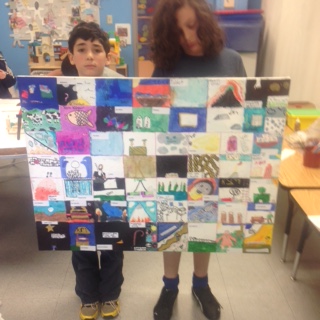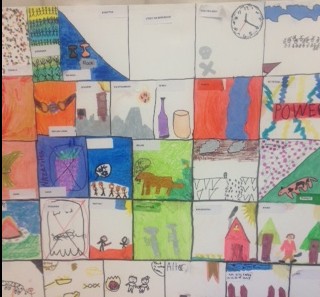 This year has been an unhurried search for wisdom. Each week we read the parashah directly from Etz Chayim and illustrated one aspect of the chapter. Our students feel that Etz Chayim is a beloved friend. They know how to reference the table of contents and check it against the Hebrew calendar to find the current chapter.
This year has been an unhurried search for wisdom. Each week we read the parashah directly from Etz Chayim and illustrated one aspect of the chapter. Our students feel that Etz Chayim is a beloved friend. They know how to reference the table of contents and check it against the Hebrew calendar to find the current chapter.
We began by counting the chapters in Etz Chayim and organizing the canvass into corresponding boxes of equal size for illustrations. Very quickly, we realized that different students were inspired by different aspects of the reading – some illustrated a visual aspect of the story, others were inspired by a word in Ivrit that jumped out at them, others responded to a color. One student observed that our planned grid would be out of sync because we found at least three visualizations in each chapter. We followed the path as it appeared before us and went with the flow. Some of our illustration boxes became different sizes.
 As a result, the first canvass represents Bereshit and Shemot. We started a second canvass. At this point, we wanted the entire Torah to unfold. To accomplish this, we labeled each box in advance with chapter names from Vayikra, B’Midbar and Dvarim and stayed on point with one story for each chapter.
As a result, the first canvass represents Bereshit and Shemot. We started a second canvass. At this point, we wanted the entire Torah to unfold. To accomplish this, we labeled each box in advance with chapter names from Vayikra, B’Midbar and Dvarim and stayed on point with one story for each chapter.
As we did this, we came to understand the relationship of the title of the chapter to the content. Last year, as a class, we evaluated Judaic textbooks and discussed the pros and cons of using “children’s books“ to study Torah. Some people felt that a summary saved time and others felt that they preferred direct access to the Torah. As we worked, most students approached the Torah directly. One of our students chose to consult the JPS commentaries on the books of the Torah. As we read the text together we discovered that some of us had formed impressions of our sacred story which are subject to discussion. A favorite discussion is that of Jacob’s encounter with a stranger. Was the stranger a man or an angel? Our discussion led us directly to the text. The colors of the two canvases bring into sharp focus the content of the stories. Blue and black prevail on one canvas; yellow and orange dominate the other. We will continue our work next year with these canvasses as a text. Our viewers will no doubt discover aspects of the Torah which we have not consciously created.
- JLC Torah Project - Thu, Jun 30, 2016
